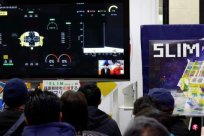
(Tokyo Composite Television) The Japanese small moon landing detector landed on the surface of the moon, becoming the fifth country in the world after the United States, the former Soviet Union, China and India.However, due to the failure of solar cells, the power of the detector may only be maintained for several hours.
Japan Cosmic Air Research and Development Institutions (JAXA) at a press conference held at 2 am on Saturday (January 20), confirmed that the moon landing detector SLIM SLIM at 00:20 Saturday time (Singapore on Friday at 11pm on Friday at 11:00 in Singapore20 points) Land on the surface of the moon.
JAXA officials pointed out that the detector can communicate with the ground normally after landing, and it can also correctly receive the instructions of the ground and respond.Can not operate.
Officials believe that the failure of solar batteries may be a problem of setting angle.They hope that with the changes in the direction of the sun, they can eventually take the solar panel of the detector to restore the detector to restore the operation.
JAXA Director of the Institute of Sciences of the Universe said at the press conference held at 2 am at 2 am: "It is unlikely that the solar cells are broken, it may be that it has no predetermined direction.It will be damaged at high speeds, and all the detection functions will be lost.
He also said that his evaluation of the moon landing mission was "just reached 60 points of passing."
Nasa, the director of the National Aeronautics and Space Agency (NASA), then posted a post in Twitter to congratulate Japan to become the fifth country to land on the moon.
McDonal, a astronomer at Harvard University, believes that Japan's moon landing mission has achieved "huge success" this time.He said that the detector can land on the surface of the moon itself is a great achievement.
As for solar cells that cannot be operated normally, he believes that the possible causes include the loosening of the wires, the wire connection error, or the position of the position when landing, so it cannot capture the sun.
Slim's main task of this moon landing is to use the spectral camera it is equipped to analyze the rock composition of the moon mantle (internal structure of the moon) to explore the origin of the moon.However, spectral cameras can only work without electricity.
SLIM is 2.7 meters long, 1.7 meters wide, and 2.4 meters high. It was launched on September 7 last year. It is the third detector in Japan to challenge the moon.Earlier, JAXA issued the first lunar detector in 2022, but eventually abandoned the task due to failure to establish communication with the ground; in April last year, the lunar lander of the Japanese private enterprise "i space company" was out of the landing point and eventually crashed.On the surface of the moon.




